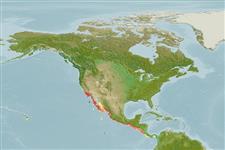Environment: milieu / climate zone / depth range / distribution range
Ecología
marino demersal; rango de profundidad 2 - 201 m (Ref. 9330). Subtropical; 37°N - 8°N
Eastern Pacific: Monterey Bay in California, USA to Costa Rica.
Tamaño / Peso / Age
Maturity: Lm ? range ? - ? cm
Max length : 25.0 cm TL macho / no sexado; (Ref. 2850); common length : 20.0 cm TL macho / no sexado; (Ref. 9330)
Short description
Claves de identificación | Morfología | Morfometría
Radios blandos dorsales (total) : 79 - 89; Radios blandos anales: 61 - 69; Vértebra: 36 - 38.
Inhabits sandy or sandy-muddy bottom (Ref. 9750). Utilized fresh.
Life cycle and mating behavior
Maturities | Reproducción | Spawnings | Egg(s) | Fecundities | Larva
Oviparous (Ref. 101737). Distinct pairing (Ref. 205). Females produce numerous eggs in multiple spawnings during a prolonged spawning period (Ref. 101737).
Eschmeyer, W.N., E.S. Herald and H. Hammann, 1983. A field guide to Pacific coast fishes of North America. Boston (MA, USA): Houghton Mifflin Company. xii+336 p. (Ref. 2850)
IUCN Red List Status (Ref. 130435)
Threat to humans
Harmless
Human uses
Pesquerías: pesquerías de subsistencia
Herramientas
Special reports
Download XML
Fuentes de Internet
Estimates based on models
Preferred temperature (Ref.
123201): 11.5 - 26, mean 18.7 °C (based on 38 cells).
Phylogenetic diversity index (Ref.
82804): PD
50 = 0.5000 [Uniqueness, from 0.5 = low to 2.0 = high].
Bayesian length-weight: a=0.00741 (0.00325 - 0.01693), b=3.15 (2.97 - 3.33), in cm total length, based on LWR estimates for this Genus-body shape (Ref.
93245).
Nivel trófico (Ref.
69278): 3.6 ±0.5 se; based on size and trophs of closest relatives
Resiliencia (Ref.
120179): Alto, población duplicada en un tiempo mínimo inferior a 15 meses (Preliminary K or Fecundity.).
Fishing Vulnerability (Ref.
59153): Low vulnerability (15 of 100).
